The following are definitions for terms used in this chapter.
(1) "Abandoning an excavation site" means not working an excavation site for forty-eight hours or longer.
(2) "Aggregate" means a mixture of minerals separable by mechanical or physical means.
(3) "Aquatic beneficial plant" means all native and nonnative aquatic plants except those on the state noxious weed lists in WAC 16-750-005, 16-750-011, and 16-750-015.
(4) "Aquatic invasive species" means an invasive species of the animal kingdom with a life cycle that is at least partly dependent upon fresh, brackish, or marine waters. Examples include certain species of waterfowl, amphibians, fish, shellfish, and nutria.
(5) "Aquatic noxious weed" means an aquatic plant on the state noxious weed lists in WAC 16-750-005, 16-750-011, and 16-750-015.
(6) "Aquatic plant" means a native or nonnative emergent, submersed, partially submersed, free-floating, or floating-leaved plant species that is dependent upon fresh, brackish, or marine water ecosystems and includes all stages of development and parts.
(7) "Aquatic Plants and Fish pamphlet" means a document that details the rules for aquatic noxious weed and aquatic beneficial plant removal and control activities and that serves as the hydraulic project approval for certain plant removal and control activities in Washington state.
(8) "Artificial materials" means clean, inert materials used to construct diversion structures for mineral prospecting.
(9) "Associated human-made agricultural drainage facilities" means dikes, drains, pumps, drainage tiles, and drainage pipe made by humans that protect agricultural land.
(10) "Authorized agent" means someone who is authorized by the applicant to act on behalf of the applicant.
(11) "Bank" means any land surface landward of the ordinary high water line next to a body of water and constrains the water except during floods. The term "bank" also includes all land surfaces of islands within a body of water that are below the flood elevation of the surrounding body of water.
(12) "Bankfull width" means the width of the surface of the water at the point where water just begins to overflow into the active flood plain. In streams where there is no flood plain it is often the width of a stream or river at the dominant channel forming flow that reoccurs every one to two years.
(13) "Beach area" means the beds between the ordinary high water line and extreme low water.
(14) "Bed" means the land below (waterward of) the ordinary high water lines of state waters. This definition does not include irrigation ditches, canals, stormwater runoff devices, or other artificial watercourses except where they exist in a natural watercourse that has been artificially altered.
(15) "Bed materials" means naturally occurring materials such as gravel, cobble, rock, rubble, sand, mud, and aquatic plants that form the beds of state waters. Bed materials are also found in deposits or bars above the wetted perimeter of water bodies.
(16) "Board" means the pollution control hearings board created in chapter 43.21B RCW.
(17) "Bottom barrier or screen" means sheets of synthetic or natural fiber material used to cover and kill plants growing on the bottom of a watercourse.
(18) "Boulder" means a stream substrate particle larger than ten inches in diameter.
(19) "Bridge shadow" means the area under a bridge defined by the shadow cast by the sun. This area may not receive enough light and rain to support the plant growth needed for biotechnical bank stabilization.
(20) "Channel bed width" means the width of the bankfull channel, although bankfull may not be well defined in some channels. For those streams which are nonalluvial or do not have flood plains, the channel width must be determined using features that do not depend on a flood plain.
(21) "Chronic danger" means a condition declared by the county legislative authority in which any property, except for property located on a marine shoreline, has experienced at least two consecutive years of flooding or erosion that has damaged or has threatened to damage a major structure, water supply system, septic system, or access to any road or highway.
(22) "Chronic danger HPA" means a written hydraulic project approval issued in response to a chronic danger declaration made by a county legislative authority.
(23) "Classify" means to sort aggregate by hand or through a screen, grizzly, or similar device to remove the larger material and concentrate the remaining aggregate.
(24) "Commission" means the Washington state fish and wildlife commission.
(25) "Compensatory mitigation" means the restoration, creation, enhancement, or preservation of aquatic resources to compensate for adverse impacts that remain after all appropriate and practicable avoidance and minimization has been achieved.
(26) "Concentrator" means a device used to physically or mechanically separate the valuable mineral content from aggregate.
(27) "Control" of an aquatic plant means to prevent all seed production and to prevent the dispersal of all propagative parts capable of forming new plants.
(28) "County legislative authority" means a county commission, council, or other legislative body.
(29) "Crevicing" means removing aggregate from cracks and crevices using hand-held mineral prospecting tools.
(30) "Critical food fish or shellfish habitats" means those habitats that are essential to fish life. These habitats include habitats of special concern listed in WAC 220-660-100 and 220-660-320.
(31) "Department" means the department of fish and wildlife.
(32) "Design flood" means a stream discharge of a specific rate and probability best suited to ensure the project design creates and shapes habitat or protects property and structures to a given level of risk (e.g., the 100-year design flood).
(33) "Director" means the director of the department of fish and wildlife.
(34) "Ditch" means a wholly artificial watercourse or a natural watercourse (waters of the state) altered by humans.
(35) "Diver-operated dredging" means the use of portable suction or hydraulic dredges held by SCUBA divers to remove aquatic plants.
(36) "Dredging" means removal of bed material using other than hand-held tools. This does not include metals mining and milling operations as defined in chapter 78.56 RCW.
(37) "Dryland dredge" means a suction dredge with a nozzle capable of introducing water under pressure from the suction dredge pump to the tip of the nozzle.
(38) "Early infestation" of an aquatic noxious weed means a stage of development, life history, or area of coverage that makes one hundred percent control and eradication likely to occur.
(39) "Emergency" means an immediate threat to life, the public, property, or of environmental degradation.
(40) "Emergency HPA" means a verbal or written hydraulic project approval issued in response to a declaration of emergency.
(41) "Entrained" means the entrapment of fish into a watercourse diversion that has no screen, into high velocity water along the face of an improperly designed screen, or into the vegetation cut by a mechanical harvester.
(42) "Equipment" means any device powered by internal combustion; hydraulics; electricity, except less than one horsepower; or livestock used as draft animals, except saddle horses; and the lines, cables, arms, or extensions associated with the device.
(43) "Eradication" of an aquatic noxious weed means to eliminate it within an area of infestation.
(44) "Established ford" means a crossing place in a watercourse that was in existence and used annually before 1986 or permitted by the department in or after 1986, and has identifiable approaches on the banks.
(45) "Excavation line" means a line on the dry bed at or parallel to the water's edge. The department determines the distance from the water's edge for each project site. The excavation line may change with water level fluctuations.
(46) "Excavation site" means the pit, furrow, or hole from which aggregate is removed to process and recover minerals, or into which wastewater is discharged to settle out sediments.
(47) "Excavation zone" means the area between the excavation line and the bank or the center of the gravel bar.
(48) "Expedited HPA" means a written hydraulic project approval issued in those instances where when normal permit processing would result in a significant hardship for the applicant or unacceptable damage to the environment.
(49) "Farm and agricultural land" means those lands identified in RCW 84.34.020.
(50) "Filter blanket" means one or more layers of pervious materials (organic, mineral, or synthetic) designed and installed to provide drainage, yet prevent the movement of soil particles by flowing water.
(51) "Fish conservation bank" means a habitat creation, restoration, or enhancement project intended to provide a bank of credits to compensate for unavoidable impacts to habitat that supports fish life from future development projects. Fish conservation banks are managed to optimize desired habitat for ESA-listed and at-risk fish species.
(52) "Fish habitat" or "habitat that supports fish life" means habitat, which is used by fish life at any life stage at any time of the year including potential habitat likely to be used by fish life, which could reasonably be recovered by restoration or management and includes off-channel habitat.
(53) "Fish habitat enhancement project" means a hydraulic project that meets criteria in RCW 77.55.181 (1)(a).
(54) "Fish habitat improvement structures" or "stream channel improvements" means natural materials such as large wood, rock, or synthetic materials such as chain or rope placed in or next to bodies of water to improve existing conditions for fish life. Examples are engineered logjams, large woody material, and boulders.
(55) "Fish guard" means a device installed at or near a surface water diversion head gate, or on the intake of any device used for removing water from fish-bearing waters, to prevent entrainment, injury, or death of fish life. Fish guards physically keep fish from entering the diversion or intake and do not rely on avoidance behavior.
(56) "Fish life" means all fish species, including food fish, shellfish, game fish, unclassified fish and shellfish species, and all stages of development of those species.
(57) "Fish passage improvement structure" means artificial structures that are used to provide passage through, over, and/or around artificial barriers. They provide a graduated change in gradient with refuge areas allowing fish to pass barriers.
(58) "Fish screen" means "fish guard."
(59) "Flood gate" means a structure to control flooding through which water flows freely in one direction but is prevented from flowing in the other direction.
(60) "Food fish" means those species of the classes Osteichthyes, Agnatha, and Chondrichthyes that must not be fished for except as authorized by rule of the commission.
(61) "Forest practices hydraulic project" means a hydraulic project that requires a forest practices application or notification under chapter 76.09 RCW.
(62) "Frequent scour zone" means the area between the wetted perimeter and the toe of the slope. The frequent scour zone is comprised of aggregate, boulders, or bedrock. Organic soils are not present in the frequent scour zone.
(63) "Freshwater area" means those state waters and associated beds waterward of the ordinary high water line that are upstream of stream and river mouths. Freshwater areas also include all lakes, ponds, and tributary streams and surface-water-connected wetlands that provide or maintain habitat that supports life. This definition does not include irrigation ditches, canals, stormwater treatment, and conveyance systems, or other entirely artificial watercourses, except where they exist in a natural watercourse that has been altered by humans.
(64) "Functional grating" means the percent open area of the grating that is not covered or blocked by any objects such as structural components, framing wood, flotation tubs, or objects placed on the surface of the grating.
(65) "Ganged equipment" means two or more pieces of mineral prospecting equipment coupled together to increase efficiency. An example is adding a second sluice to a high-banker.
(66) "General provisions" means those provisions that are in every HPA.
(67) "Gold and Fish pamphlet" means a document that details the rules for conducting small-scale and other prospecting and mining activities and that serves as the hydraulic project approval for certain mineral prospecting and mining activities in Washington state.
(68) "Gravity siphon aquatic mining" means any prospecting or mining activity that uses water drawn into a hose, pipe, or tube via the effects of gravity or siphon to excavate, concentrate, or process aggregate.
(69) "Habitat function" means the natural attributes of a given habitat that support the fish life that rely upon that habitat.
(70) "Habitat value" means an estimate of habitat quality, ecologically important functions and the relative value of the hydraulic project site within the watershed.
(71) "Hand-held equipment" means equipment held by hand and powered by internal combustion, hydraulics, pneumatics, or electricity. Examples are chainsaws, drills, and grinders.
(72) "Hand-held mineral prospecting tools" means tools used for mineral prospecting that are held by hand and do not have moving parts powered, in whole or in part, by internal combustion, electricity, hydraulics, or pneumatics. Examples include, but are not necessarily limited to, shovels, picks, trowels, hammers, and pry bars.
(73) "Hand-held tools" means tools held by hand and are not powered by internal combustion, hydraulics, pneumatics, or electricity. Examples are shovels, rakes, hammers, pry bars, and cable winches. This definition does not apply to hand-held tools used for mineral prospecting. See "hand-held mineral prospecting tools."
(74) "Hatchery" means any water impoundment or facility used for the captive spawning, hatching, or rearing of fish life.
(75) "High-banker" means a stationary concentrator operated outside the wetted perimeter of the body of water from which the water is removed and that uses water supplied by hand or by pumping. A high-banker consists of a sluice box, hopper, and water supply. Aggregate is supplied to the high-banker by means other than suction dredging. This definition excludes rocker boxes. See Figure 1.
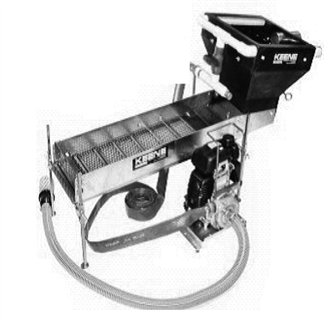 |
Figure 1: High-banker
(76) "High-banking" means using a high-banker to recover minerals.
(77) "Hydraulic drop" means an abrupt drop in water surface elevation.
(78) "Hydraulic project" means the construction or performance of work that will use, divert, obstruct, or change the natural flow or bed of any of the salt or freshwaters of the state.
(79) "Hydraulic project approval" or "HPA" means:
(a) A written approval for a hydraulic project issued under this chapter and signed by the director of the department or the director's designee; or
(b) A verbal approval for an emergency hydraulic project issued under this chapter by the director of the department or the director's designee; or
(c) The following printed pamphlet approvals:
(i) A "Gold and Fish" pamphlet issued under this chapter by the department, which identifies and authorizes specific small scale mineral prospecting and placer mining activities; or
(ii) An "Aquatic Plants and Fish" pamphlet issued under this chapter by the department, which identifies and authorizes specific aquatic plant removal and control activities.
(80) "Imminent danger" means a threat by weather, water flow, or other natural conditions that is likely to occur within sixty days of a request for a permit application.
(81) "In-lieu fee (ILF) program" means a state or federal certified program authorizing a person pay a fee to a third party instead of conducting project-specific mitigation or buying credits from a mitigation or fish conservation bank.
(82) "In-water blasting" means the use of explosives on, under, or in waters of the state, or in any location adjacent to the waters of the state, where blasting could impact fish life or habitat that supports fish life.
(83) "Job site" means the area of ground including and immediately adjacent to the area where work is conducted under an HPA. For mineral prospecting and placer mining projects, the job site includes the excavation site.
(84) "Joint aquatic resources permit application" or "JARPA" means a form provided by the department and other agencies that a person may submit to request a written HPA for a hydraulic project.
(85) "Lake" means any natural standing fresh waters or artificially impounded natural fresh waters of the state, except impoundments of the Columbia and Snake rivers.
(86) "Large woody material" means trees or tree parts larger than four inches in diameter and longer than six feet, or rootwads, wholly or partially waterward of the ordinary high water line.
(87) "Macroalgae" means any of the nonvascular aquatic plant species (the red, green, or brown seaweeds) that can be seen without using a microscope. They may be attached to the substrate or other macroalgae by a holdfast, or found drifting individually or in mats.
(88) "Maintenance" means repairing, remodeling, or making minor alterations to a facility or project to keep the facility or project in properly functioning and safe condition.
(89) "Major modification" means any change to a hydraulic project approval that is not a minor modification.
(90) "Marina" means a public or private facility providing boat moorage space, fuel, or commercial services. Commercial services include overnight or live-aboard boating accommodations.
(91) "Marine terminal" means a public or private commercial wharf located in navigable waters of the state and used, or intended to be used, as a port or facility for storing, handling, transferring, or transporting goods to and from vessels.
(92) "Mean annual flood" means the average of all the annual peak floods of record.
(93) "Mean higher high water" or "MHHW" means the tidal elevation obtained by averaging each day's highest tide at a particular location over a period of nineteen years, as determined by National Oceanic and Atmospheric Administration (NOAA). It is measured from mean lower low water, which is a reference datum used to delineate waters of the state in saltwater areas.
(94) "Mean lower low water" or "MLLW" means the 0.0 feet tidal elevation, as determined by NOAA. It is determined by averaging each day's lowest tide at a particular location over a period of nineteen years. MLLW is a reference datum used to delineate waters of the state in saltwater areas. NOAA provides detailed information on their "Tides, Currents, and Predictions" website.
(95) "Mechanical harvesting and cutting" means partially removing or controlling aquatic plants by using aquatic mechanical harvesters, which cut and collect aquatic plants, and mechanical cutters, which only cut aquatic plants.
(96) "Mineral prospect" or "mineral prospecting" means to excavate, process, or classify aggregate using hand-held mineral prospecting tools and mineral prospecting equipment.
(97) "Mineral prospecting equipment" means any natural or manufactured device, implement, or animal (other than the human body) used in any aspect of prospecting for or recovering minerals.
(98) "Mini high-banker" means a high-banker with a riffle area of three square feet or less. See Figure 2.
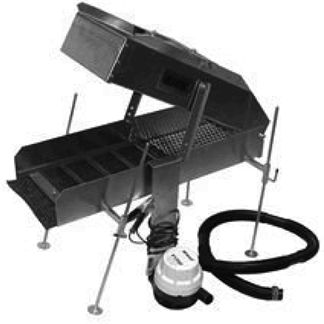 |
Figure 2: Mini high-banker
(99) "Mini rocker box" means a rocker box with a riffle area of three square feet or less. See Figure 3.
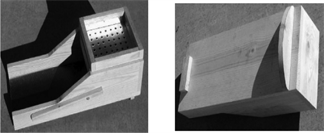 |
Figure 3: Mini rocker box (top view and bottom view)
(100) "Mining" means the production activity that follows mineral prospecting.
(101) "Minor modification" means a small change in work timing or plans and specifications of a hydraulic project.
(102) "Mitigation" means sequentially avoiding impacts, minimizing impacts, and compensating for remaining unavoidable impacts to fish life or habitat that supports fish life.
(103) "Mitigation bank" means a site where wetlands or other aquatic resources are restored, created, enhanced, or preserved. The bank exists expressly to provide compensatory mitigation before unavoidable impacts to wetlands or other aquatic resources occur.
(104) "Mitigation sequence" means the successive steps that the department and the applicant must consider and implement to protect fish life when constructing or performing work. These steps must be considered and implemented in the order listed:
(a) Avoid the impact altogether by not taking a certain action or parts of an action.
(b) Minimize unavoidable impacts by limiting the degree or magnitude of the action and its implementation by using appropriate technology or by taking steps to reduce impacts.
(c) Rectify the impact by repairing, rehabilitating, or restoring the affected environment.
(d) Reduce or eliminate the impact over time.
(e) Compensate for remaining unmitigated impacts by replacing, enhancing, or providing substitute resources or environments.
(f) Monitor the impact and take appropriate corrective measures to reach the identified goal.
(105) "Motorized or gravity siphon equipment" means any form of motorized equipment including, but not limited to, a motorized suction dredge or a gravity siphon suction dredge, for the purpose of extracting gold, silver, or other precious metals, but does not include metals mining and milling operations as defined in RCW 78.56.020.
(106) "Multiple site permit" means a hydraulic project approval issued to a person under RCW 77.55.021 for hydraulic projects occurring at more than one specific location and which includes site-specific requirements.
(107) "Natural conditions" means environmental situations that occur or are found in nature. This does not include artificial or manufactured conditions.
(108) "Nearshore" means shallow waters where sunlight reaching the bed is sufficient to support the growth of submerged aquatic vegetation.
(109) "Nearshore zone" means the three critical "edge" habitats as follows: The edge between upland and aquatic environments, the edge between the shallow productive zone and deep water, and the edge between fresh and marine waters.
(110) "No net loss" means:
(a) Sequentially for avoiding impacts, minimizing unavoidable impacts, and compensating for remaining adverse impacts to fish life.
(b) Sequentially avoiding impacts, minimizing unavoidable impacts, and compensating for net loss of habitat functions necessary to sustain fish life.
(c) Sequentially avoiding impacts, minimizing unavoidable impacts, and compensating for loss of area by habitat type.
(d) Mitigation required to achieve no net loss should benefit the fish life being impacted.
(111) "Ordinary high water line" or "OHWL" means the mark on the shores of all water that will be found by examining the bed and banks and ascertaining where the presence and action of waters are so common and usual, and so long continued in ordinary years as to mark upon the soil or vegetation a character distinct from the abutting upland. Provided, that in any area where the ordinary high water line cannot be found, the ordinary high water line adjoining saltwater is the line of mean higher high water and the ordinary high water line adjoining freshwater is the elevation of the mean annual flood.
(112) "Pan" means an open metal or plastic dish operated by hand to separate gold or other minerals from aggregate by washing the aggregate. See Figure 4.
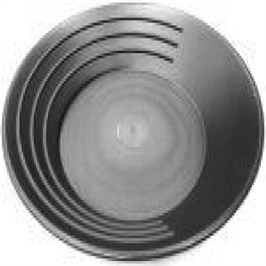 |
Figure 4: Pan
(113) "Panning" means the use of a pan to wash aggregate.
(114) "Permanent ford" means a ford approved by the department that is in place for more than one operating season.
(115) "Person" means an applicant, authorized agent, permittee, or contractor. The term person includes an individual, a public or private entity, or organization.
(116) "Placer" means a glacial or alluvial deposit of gravel or sand containing eroded particles of minerals.
(117) "Pool" means a portion of the stream with reduced current velocity, often with water deeper than the surrounding areas.
(118) "Power sluice" means "high-banker."
(119) "Power sluice/suction dredge combination" means a machine that can be used as a power sluice, or with minor modifications, as a suction dredge. See Figure 5.
 |
Figure 5: Power sluices/suction dredge combination
(120) "Process aggregate" or "processing aggregate" means the physical or mechanical separation of the valuable mineral content within aggregate.
(121) "Protection of fish life" means avoiding, minimizing unavoidable impacts, and compensating for remaining impacts to fish life and the habitat that supports fish life through mitigation sequencing.
(122) "Purple loosestrife" means Lythrum salicaria and Lythrum virgatum as classified in RCW 17.10.010(10) and defined in RCW 17.26.020 (5)(b).
(123) "Qualified professional" means a scientist, engineer, or technologist specializing in a relevant applied science or technology including fisheries or wildlife biology, engineering, geomorphology, geology, hydrology, or hydrogeology. This person may be certified with an appropriate professional organization, and acting under that association's code of ethics and subject to disciplinary action by that association. A qualified professional can also be someone who, through demonstrated education, experience, accreditation, and knowledge relevant to the particular matter, may be reasonably relied on to provide advice within that person's area of expertise. This definition does not supersede other state laws that govern the qualifications of professionals that perform hydraulic projects.
(124) "Redd" means a nest made in gravel, consisting of a depression dug by a fish for egg deposition, and associated gravel mounds. See Figure 6.
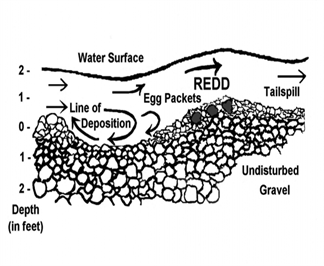 |
Figure 6: Cross-section of a typical redd
(125) "Rehabilitation" means major work required to restore the integrity of a structurally deficient or functionally obsolete structure. This can include partial replacement of a structure.
(126) "Replacement" means the complete removal of an existing structure and construction of a substitute structure in the same general location.
(127) "Riffle" means:
(a) The bottom of a concentrator containing a series of interstices or grooves to catch and retain a mineral such as gold; or
(b) A short, relatively shallow and coarse-bedded length of stream over which the stream flows at higher velocity and higher turbulence than it normally does in comparison to a pool.
(128) "River" means "watercourse."
(129) "Riparian zones" means the land adjacent to streams, rivers, ponds, lakes, and those wetlands whose soils and vegetation are influenced by ponded or channelized water. They are the transition areas between aquatic and upland habitats often with elements of both ecosystems.
(130) "Rocker box" means a nonmotorized concentrator consisting of a hopper attached to a cradle and a sluice box operated with a rocking motion. See Figure 7.
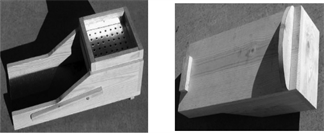 |
Figure 7: Rocker box
(131) "Rotovation" means the use of aquatic rotovators, machines that have underwater rototiller-like blades, to uproot aquatic plants as a means of control.
(132) "Roughened channel" means to construct a channel of a graded mix of sediment with enough roughness and hydraulic diversity to achieve fish passage. Roughened channels are designed to resist erosion and are often built at a steeper gradient than the prevailing channel.
(133) "Saltwater area" means those state waters and associated beds waterward of the ordinary high water line in Puget Sound, the Strait of Juan de Fuca and the open coast. Saltwater areas include estuaries and other surface-water-connected wetlands that provide or maintain habitat that support fish life. This definition does not include irrigation ditches, canals, stormwater treatment and conveyance systems, or other entirely artificial watercourses, except where they exist in a natural watercourse that has been altered by humans.
(134) "Scientific measurement devices" means devices that measure and/or record environmental data, such as staff gauges, tide gauges, water recording devices, water quality testing and improvement devices, and similar instruments.
(135) "Seagrass" means native Zostera species, Ruppia maritima, and Phyllospadix species.
(136) "Shellfish" means those species of marine and freshwater invertebrates that have been classified and that must not be taken except as authorized by rule of the commission. The term shellfish includes all stages of development and the bodily parts of shellfish species.
(137) "Sluice" means a trough equipped with riffles across its bottom used to recover gold and other minerals with the use of flowing water. See Figure 8.
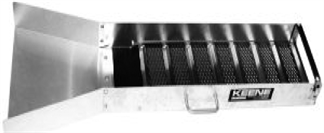 |
Figure 8: Sluice
(138) "Spartina" means Spartina alterniflora, Spartina anglica, Spartina x townsendii, and Spartina patens as classified in RCW 17.10.010(10) and defined in RCW 17.26.020 (5)(a).
(139) "Special provisions" means those requirements that are part of a HPA, are site- or project-specific, and supplement or amend the technical provisions.
(140) "Spiral wheel" means a hand-operated or battery-powered rotating pan used to recover gold and minerals with the use of water. See Figure 9.
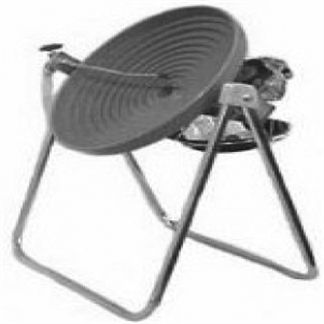 |
Figure 9: Spiral wheel
(141) "Stable slope" means a slope without measurable evidence of slumping, sloughing, or other movement. Stable slopes will not show evidence of landslides, uprooted or tilted trees, exposed soils, water-saturated soils, and mud, or the recent erosion of soils and sediment. Woody vegetation is typically present on stable slopes.
(142) "Suction dredge" means any motorized or nonmotorized device that removes aggregate from the bed, banks, or uplands by means of vacuum created by water flowing through a tube or hose. Bulb snifters are not considered suction dredges. See Figure 10.
 |
Figure 10: Suction dredge
(143) "Suction dredging" means using a suction dredge to recover gold and other minerals.
(144) "Tailings" means the waste material that remains after processing aggregate to remove valuable mineral content.
(145) "Temporary ford" means a ford that is in place for no more than one operating season or less.
(146) "Tide gate" means a one-way check valve that prevents the backflow of tidal water.
(147) "Toe of the bank" means the distinct break in slope between the stream bank or shoreline and the stream bottom or marine beach or bed, excluding areas of sloughing. For steep banks that extend into the water, the toe may be submerged waterward of the ordinary high water line. For artificial structures, such as jetties or bulkheads, the toe refers to the base of the structure where it meets the stream bed or marine beach or bed.
(148) "Toe of the slope" means the base or bottom of a slope at the point where the ground surface abruptly changes to a significantly flatter grade.
(149) "Unimpeded fish passage" means the free movement of all fish species at any mobile life stage around or through a human-made or natural structure.
(150) "Unstable slope" means a slope with visible or measurable evidence of slumping, sloughing, or other movement. Evidence of unstable slopes includes landslides, uprooted or tilted trees, exposed soils, water-saturated soils, and mud, or the recent erosion of soils and sediment. Woody vegetation is typically not present on unstable slopes.
(151) "Water crossing structures" means structures that span over, through, or under a watercourse. Examples are bridges, culverts, conduits, and fords.
(152) "Water right" means a certificate of water right, a vested water right or a claim to a valid vested water right, or a water permit, under Title 90 RCW.
(153) "Water body" means "waters of the state."
(154) "Watercourse," "river" or "stream" means any portion of a stream or river channel, bed, bank, or bottom waterward of the ordinary high water line of waters of the state. Watercourse also means areas in which fish may spawn, reside, or pass, and tributary waters with defined bed or banks that influence the quality of habitat downstream. Watercourse also means waters that flow intermittently or that fluctuate in level during the year, and the term applies to the entire bed of such waters whether or not the water is at peak level. A watercourse includes all surface-water-connected wetlands that provide or maintain habitat that supports fish life. This definition does not include irrigation ditches, canals, stormwater treatment and conveyance systems, or other entirely artificial watercourses, except where they exist in a natural watercourse that has been altered by humans.
(155) "Waters of the state" or "state waters" means all salt and freshwaters waterward of the ordinary high water line and within the territorial boundary of the state.
(156) "Weed rolling" means the use of a mechanical roller designed to control aquatic plant growth.
(157) "Wetland(s)" is as defined in RCW 90.58.030.
(158) "Wetted perimeter" means the areas of a watercourse covered with water. The wetted perimeter varies with flow, discharge, and tides.
(159) "Woody vegetation" means perennial trees and shrubs having stiff stems and bark. Woody vegetation does not include grasses, forbs, or annual plants.
(160) "Written notice" or "written notification" means a communication through U.S. mail or email.